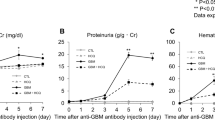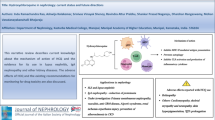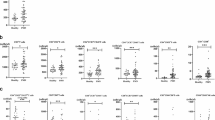Abstract
Purpose
Dendritic cells, Toll-like receptor (TLR), interleukin-6 (IFN-α), interferon-alpha (IFN-α) and tumor necrosis factor-alpha (TNF-α) play an important role in the pathogenesis of IgA nephropathy (IgAN). Hydroxychloroquine (HCQ) is an antimalarial agent and had a notable impact on immune activation by the reduction of circulating activated immune cells that including decreased TLR-expressing cells, reduced IFN-secreting DCs, reduced production of cytokines including IFN-α,IL-6 and TNF-α. We evaluated the efficacy of HCQ in reducing proteinuria in patients with IgAN.
Methods
Twenty-eight IgAN patients with persistent proteinuria (0.5–2.0 g/24 h) despite treatment with losartan for 3 months were matched to receive HCQ and losartan (group 1) or continue losartan therapy (group 2) for 24 weeks. The primary end point of this prospective, paired case–control study was reduction of proteinuria by 50% or more over entry level.
Results
Six patients (42.9%) in group one versus two patients (14.3%) in group 2 reach the primary end point (P = 0.004). By 24 weeks, the mean urinary protein excretion was 65.9 ± 25.5% (P = 0.002) and 95.3 ± 30.0% (P = 0.791) that of the corresponding baseline value in group 1 and group 2, respectively. Baseline proteinuria and histologic grades, blood pressure control and changes in serum creatinine and eGFR were not different between the two groups.
Conclusions
In selected patients with IgAN, HCQ is effective in ameliorating proteinuria.





Similar content being viewed by others
Abbreviations
- IgAN:
-
IgA nephropathy
- ESRD:
-
End stage renal disease
- DCs:
-
Dendritic cells
- TLR:
-
Toll-like receptor
- IL-6:
-
Interleukin-6
- IFN-α:
-
Interferon-alpha
- TNF-α:
-
Tumor necrosis factor-alpha
- HCQ:
-
Hydroxychloroquine
References
Donadio JV, Grande JP (2002) IgA nephropathy. N Engl J Med 347:738–748
Droz D, Kramar A, Nawar T, Noel LH (1984) Primary IgA nephropathy: prognostic factors. Contrib Nephrol 40:202–207
Beukhof JR, Kardaun O, Schaafsma W, Poortema K, Donker AJ, Hoedemaeker PJ, van der Hem GK (1986) Toward individual prognosis of IgA nephropathy. Kidney Int 29:549–556
Velo M, Lozano L, Egido J, Gutierrez-Millet V, Hernando L (1987) Natural history of IgA nephropathy in patients followed-up for more than ten years in Spain. Semin Nephrol 7:346–350
Praga M, Gutierrez E, Gonzalez E, Morales E, Hernandez E (2003) Treatment of IgA nephropathy with ACE inhibitors: a randomized and controlled trial. J Am Soc Nephrol 14:1578–1583
Lv J, Xu D, Perkovic V, Ma X, Johnson DW, Woodward M, Levin A, Zhang H, Wang H, Group TS (2012) Corticosteroid therapy in IgA nephropathy. J Am Soc Nephrol 23:1108–1116
Woo KT, Lee GS (1991) The treatment of mesangial IgA nephropathy with cyclophosphamide, dipyridamole and warfarin. Clin Nephrol 35:184
Maes BD, Oyen R, Claes K, Evenepoel P, Kuypers D, Vanwalleghem J, Van Damme B, Vanrenterghem YF (2004) Mycophenolate mofetil in IgA nephropathy: results of a 3-year prospective placebo-controlled randomized study. Kidney Int 65:1842–1849
Yu HH, Chu KH, Yang YH, Lee JH, Wang LC, Lin YT, Chiang BL (2011) Genetics and immunopathogenesis of IgA nephropathy. Clin Rev Allergy Immunol 41:198–213
Tezuka H, Abe Y, Iwata M, Takeuchi H, Ishikawa H, Matsushita M, Shiohara T, Akira S, Ohteki T (2007) Regulation of IgA production by naturally occurring TNF/iNOS-producing dendritic cells. Nature 448:929–933
Kajiyama T, Suzuki Y, Kihara M, Suzuki H, Horikoshi S, Tomino Y (2011) Different pathological roles of toll-like receptor 9 on mucosal B cells and dendritic cells in murine IgA nephropathy. Clin Dev Immunol 2011:819646
Eijgenraam JW, Reinartz SM, Kamerling SW, van Ham VJ, Zuidwijk K, van Drunen CM, Daha MR, Fokkens WJ, van Kooten C (2008) Immuno-histological analysis of dendritic cells in nasal biopsies of IgA nephropathy patients. Nephrol Dial Transplant 23:612–620
Coppo R, Camilla R, Amore A, Peruzzi L, Dapra V, Loiacono E, Vatrano S, Rollino C, Sepe V, Rampino T, Dal Canton A (2010) Toll-like receptor 4 expression is increased in circulating mononuclear cells of patients with immunoglobulin A nephropathy. Clin Exp Immunol 159:73–81
Suzuki H, Suzuki Y, Narita I, Aizawa M, Kihara M, Yamanaka T, Kanou T, Tsukaguchi H, Novak J, Horikoshi S, Tomino Y (2008) Toll-like receptor 9 affects severity of IgA nephropathy. J Am Soc Nephrol 19:2384–2395
Fagarasan S, Kawamoto S, Kanagawa O, Suzuki K (2010) Adaptive immune regulation in the gut: T cell-dependent and T cell-independent IgA synthesis. Annu Rev Immunol 28:243–273
Wardle EN (2004) Is IgA nephropathy induced by hyperproduction of interferon-alpha? Med Hypotheses 62:625–628
Lai KN, Tang SC, Leung JC (2011) Recent advances in IgA nephropathy—the glomerulopodocytic-tubular communication. Adv Otorhinolaryngol 72:40–44
Sacre K, Criswell LA, McCune JM (2012) Hydroxychloroquine is associated with impaired interferon-alpha and tumor necrosis factor-alpha production by plasmacytoid dendritic cells in systemic lupus erythematosus. Arthritis Res Ther 14:R155
Piconi S, Parisotto S, Rizzardini G, Passerini S, Terzi R, Argenteri B, Meraviglia P, Capetti A, Biasin M, Trabattoni D, Clerici M (2011) Hydroxychloroquine drastically reduces immune activation in HIV-infected, antiretroviral therapy-treated immunologic nonresponders. Blood 118:3263–3272
Kasitanon N, Fine DM, Haas M, Magder LS, Petri M (2006) Hydroxychloroquine use predicts complete renal remission within 12 months among patients treated with mycophenolate mofetil therapy for membranous lupus nephritis. Lupus 15:366–370
Pons-Estel GJ, Alarcon GS, McGwin G Jr, Danila MI, Zhang J, Bastian HM, Reveille JD, Vila LM, Lumina Study G (2009) Protective effect of hydroxychloroquine on renal damage in patients with lupus nephritis: LXV, data from a multiethnic US cohort. Arthritis Rheum 61:830–839
Lee SM, Rao VM, Franklin WA, Schiffer MS, Aronson AJ, Spargo BH, Katz AI (1982) IgA nephropathy: morphologic predictors of progressive renal disease. Hum Pathol 13:314–322
Cattran DC, Coppo R, Cook HT, Feehally J, Roberts IS, Troyanov S, Alpers CE, Amore A, Barratt J, Berthoux F, Bonsib S, Bruijn JA, D’Agati V, D’Amico G, Emancipator S, Emma F, Ferrario F, Fervenza FC, Florquin S, Fogo A, Geddes CC, Groene HJ, Haas M, Herzenberg AM, Hill PA, Hogg RJ, Hsu SI, Jennette JC, Joh K, Julian BA, Kawamura T, Lai FM, Leung CB, Li LS, Li PK, Liu ZH, Mackinnon B, Mezzano S, Schena FP, Tomino Y, Walker PD, Wang H, Weening JJ, Yoshikawa N, Zhang H (2009) The Oxford classification of IgA nephropathy: rationale, clinicopathological correlations, and classification. Kidney Int 76:534–545
Novak J, Tomana M, Matousovic K, Brown R, Hall S, Novak L, Julian BA, Wyatt RJ, Mestecky J (2005) IgA1-containing immune complexes in IgA nephropathy differentially affect proliferation of mesangial cells. Kidney Int 67:504–513
Wang Y, Zhao MH, Zhang YK, Li XM, Wang HY (2004) Binding capacity and pathophysiological effects of IgA1 from patients with IgA nephropathy on human glomerular mesangial cells. Clin Exp Immunol 136:168–175
Monteiro RC, Moura IC, Launay P, Tsuge T, Haddad E, Benhamou M, Cooper MD, Arcos-Fajardo M (2002) Pathogenic significance of IgA receptor interactions in IgA nephropathy. Trends Mol Med 8:464–468
Puga I, Cols M, Cerutti A (2010) Innate signals in mucosal immunoglobulin class switching. J Allergy Clin Immunol 126:889–895 quiz 896–7
McCarthy DD, Chiu S, Gao Y, Summers-deLuca LE, Gommerman JL (2006) BAFF induces a hyper-IgA syndrome in the intestinal lamina propria concomitant with IgA deposition in the kidney independent of LIGHT. Cell Immunol 241:85–94
Sperber K, Quraishi H, Kalb TH, Panja A, Stecher V, Mayer L (1993) Selective regulation of cytokine secretion by hydroxychloroquine: inhibition of interleukin 1 alpha (IL-1-alpha) and IL-6 in human monocytes and T cells. J Rheumatol 20:803–808
Karres I, Kremer JP, Dietl I, Steckholzer U, Jochum M, Ertel W (1998) Chloroquine inhibits proinflammatory cytokine release into human whole blood. Am J Physiol 274:R1058–R1064
Hoshino K, Sugiyama T, Matsumoto M, Tanaka T, Saito M, Hemmi H, Ohara O, Akira S, Kaisho T (2006) IkappaB kinase-alpha is critical for interferon-alpha production induced by Toll-like receptors 7 and 9. Nature 440:949–953
Scheinecker C, Zwolfer B, Koller M, Manner G, Smolen JS (2001) Alterations of dendritic cells in systemic lupus erythematosus: phenotypic and functional deficiencies. Arthritis Rheum 44:856–865
Blomberg S, Eloranta ML, Magnusson M, Alm GV, Ronnblom L (2003) Expression of the markers BDCA-2 and BDCA-4 and production of interferon-alpha by plasmacytoid dendritic cells in systemic lupus erythematosus. Arthritis Rheum 48:2524–2532
Kwok SK, Lee JY, Park SH, Cho ML, Min SY, Park SH, Kim HY, Cho YG (2008) Dysfunctional interferon-alpha production by peripheral plasmacytoid dendritic cells upon Toll-like receptor-9 stimulation in patients with systemic lupus erythematosus. Arthritis Res Ther 10:R29
Siegal FP, Kadowaki N, Shodell M, Fitzgerald-Bocarsly PA, Shah K, Ho S, Antonenko S, Liu YJ (1999) The nature of the principal type 1 interferon-producing cells in human blood. Science 284:1835–1837
Coppo R, Troyanov S, Bellur S, Cattran D, Cook HT, Feehally J, Roberts IS, Morando L, Camilla R, Tesar V, Lunberg S, Gesualdo L, Emma F, Rollino C, Amore A, Praga M, Feriozzi S, Segoloni G, Pani A, Cancarini G, Durlik M, Moggia E, Mazzucco G, Giannakakis C, Honsova E, Sundelin BB, Di Palma AM, Ferrario F, Gutierrez E, Asunis AM, Barratt J, Tardanico R, Perkowska-Ptasinska A (2014) Validation of the Oxford classification of IgA nephropathy in cohorts with different presentations and treatments. Kidney Int 86:828–836
Coppo R, D’Amico G (2005) Factors predicting progression of IgA nephropathies. J Nephrol 18:503–512
Le W, Liang S, Hu Y, Deng K, Bao H, Zeng C, Liu Z (2012) Long-term renal survival and related risk factors in patients with IgA nephropathy: results from a cohort of 1155 cases in a Chinese adult population. Nephrol Dial Transplant 27:1479–1485
Author's contribution
Ruitong Gao carried out data collection, statistical analysis and interpretation of results, as well as drafting the manuscript. Yubing Wen assessed the renal biopsies. Wei Wu participated in data collection. Xuemei Li conceived the study and participated in the study design, data collection, interpretation of results and drafting the manuscript. All authors critically revised the manuscript as well as reading and approving the final version prior to submission.
Author information
Authors and Affiliations
Corresponding author
Ethics declarations
Conflict of interest
None of the authors have any competing interests.
Rights and permissions
About this article
Cite this article
Gao, R., Wu, W., Wen, Y. et al. Hydroxychloroquine alleviates persistent proteinuria in IgA nephropathy. Int Urol Nephrol 49, 1233–1241 (2017). https://doi.org/10.1007/s11255-017-1574-2
Received:
Accepted:
Published:
Issue Date:
DOI: https://doi.org/10.1007/s11255-017-1574-2




